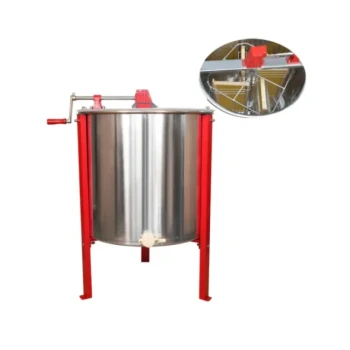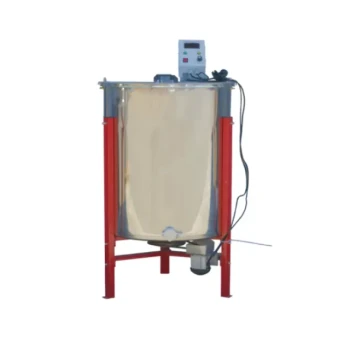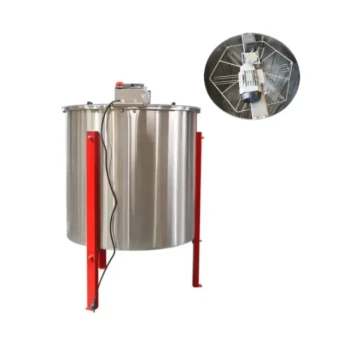There are two primary ways to extract honey by hand: the "crush and strain" method and using a hand-crank centrifugal extractor. The crush and strain method is the simplest, involving cutting the comb from the frame, crushing it to release the honey, and then straining the mixture through filters to separate the honey from the wax. Using a manual extractor requires more specialized equipment but preserves the delicate wax comb for the bees to reuse.
The core decision in manual honey extraction is choosing between simplicity and hive efficiency. The crush and strain method is accessible and requires minimal equipment, but it destroys the comb. Using a hand-crank extractor requires a larger initial investment but saves the comb, allowing bees to produce more honey in the long run.
The Two Philosophies of Manual Extraction
Understanding the two main approaches will help you determine the right path for your goals as a beekeeper. Each method has a different impact on your equipment needs and your bees.
Destructive Extraction: The Crush and Strain Method
This is the oldest and most straightforward technique. It is ideal for beekeepers with only one or two hives, those using frameless or top-bar hives, or anyone who wants to avoid buying specialized machinery.
The process involves physically destroying the wax comb to release the honey. Because the bees must rebuild this comb from scratch—a process that consumes about eight pounds of honey to produce one pound of wax—it is considered less efficient for the hive.
Non-Destructive Extraction: Using a Manual Extractor
This method uses centrifugal force to pull honey from the comb's cells without damaging the comb structure itself. It is the preferred method for beekeepers who plan to manage several hives over many years.
By preserving the "drawn comb," you give the bees a massive head start for the next honey flow. They can immediately begin storing new nectar instead of spending weeks rebuilding their wax infrastructure. This almost always leads to higher honey yields over time.
The Step-by-Step Process: Crush and Strain
For its simplicity and low cost, crush and strain is the most common starting point for new beekeepers.
Step 1: Cut the Comb from the Frame
Using a long, clean knife, carefully slice the honeycomb away from the wooden frame. Let the slab of comb fall into a food-grade bucket or a large, clean pan.
Step 2: Crush the Comb
With a potato masher, dough cutter, or even just clean hands, break up and crush the honeycomb. The goal is to rupture all the individual wax cells to release the honey they hold.
Step 3: Strain the Honey
Place a coarse filter over a clean, food-grade bucket. You can use a dedicated honey strainer or layers of cheesecloth. Pour the honey-and-wax slurry into the filter and let gravity do the work. This can take several hours. A second, finer-mesh filter can be used afterward for greater clarity.
Step 4: Jar and Process the Wax
Once the honey has drained, you can pour it into clean jars. The remaining wax in the filter is a valuable byproduct that can be washed and rendered into blocks for making candles, salves, or wood polish.
Understanding the Trade-offs
Neither method is universally "better"; the right choice depends entirely on your situation and goals.
Crush and Strain: Simplicity vs. Sacrificed Comb
This method's primary advantage is its low barrier to entry. You only need basic kitchen tools like knives, buckets, and strainers.
The significant disadvantage is the destruction of the comb. You are essentially resetting the bees' progress, forcing them to expend valuable energy and resources rebuilding wax instead of gathering more nectar.
Manual Extractor: Efficiency vs. Initial Investment
The key benefit here is hive productivity. By returning the empty "wet" frames to the hive, you give bees a foundation to refill immediately, maximizing your potential honey harvest.
The downside is the cost and storage of the extractor. A hand-crank extractor is a single-purpose machine that represents a notable financial investment for a hobbyist.
Choosing the Right Method for Your Goal
- If your primary focus is simplicity and low cost for one or two hives: The crush and strain method is the most practical and economical starting point.
- If your primary focus is long-term honey production and managing multiple hives: Investing in a manual extractor will pay for itself over time through increased hive efficiency and larger harvests.
- If your primary focus is processing both honey and beeswax for other projects: The crush and strain method is ideal, as it leaves you with a clean separation of both valuable resources.
Ultimately, the method you choose is simply a means to the rewarding end of enjoying pure honey you harvested yourself.
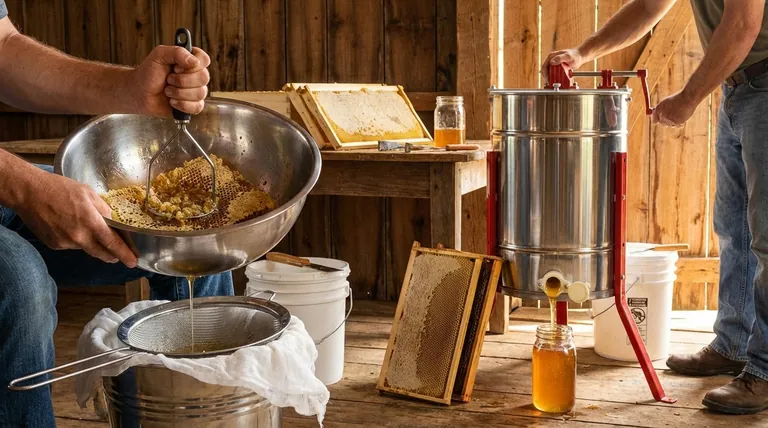
Summary Table:
| Method | Key Feature | Best For | Primary Trade-off |
|---|---|---|---|
| Crush & Strain | Destroys the comb | Hobbyists, 1-2 hives, top-bar hives | Simplicity vs. lost hive efficiency |
| Manual Extractor | Preserves the comb | Beekeepers with multiple hives | Higher yield vs. equipment investment |
Ready to Scale Your Honey Harvest?
Whether you're a hobbyist perfecting your crush and strain technique or a commercial apiary ready to invest in efficient extraction, HONESTBEE has the durable, high-quality equipment you need. We supply beekeepers and distributors with the reliable tools for a successful harvest.
Contact our wholesale experts today to discuss your beekeeping supply needs!
Visual Guide
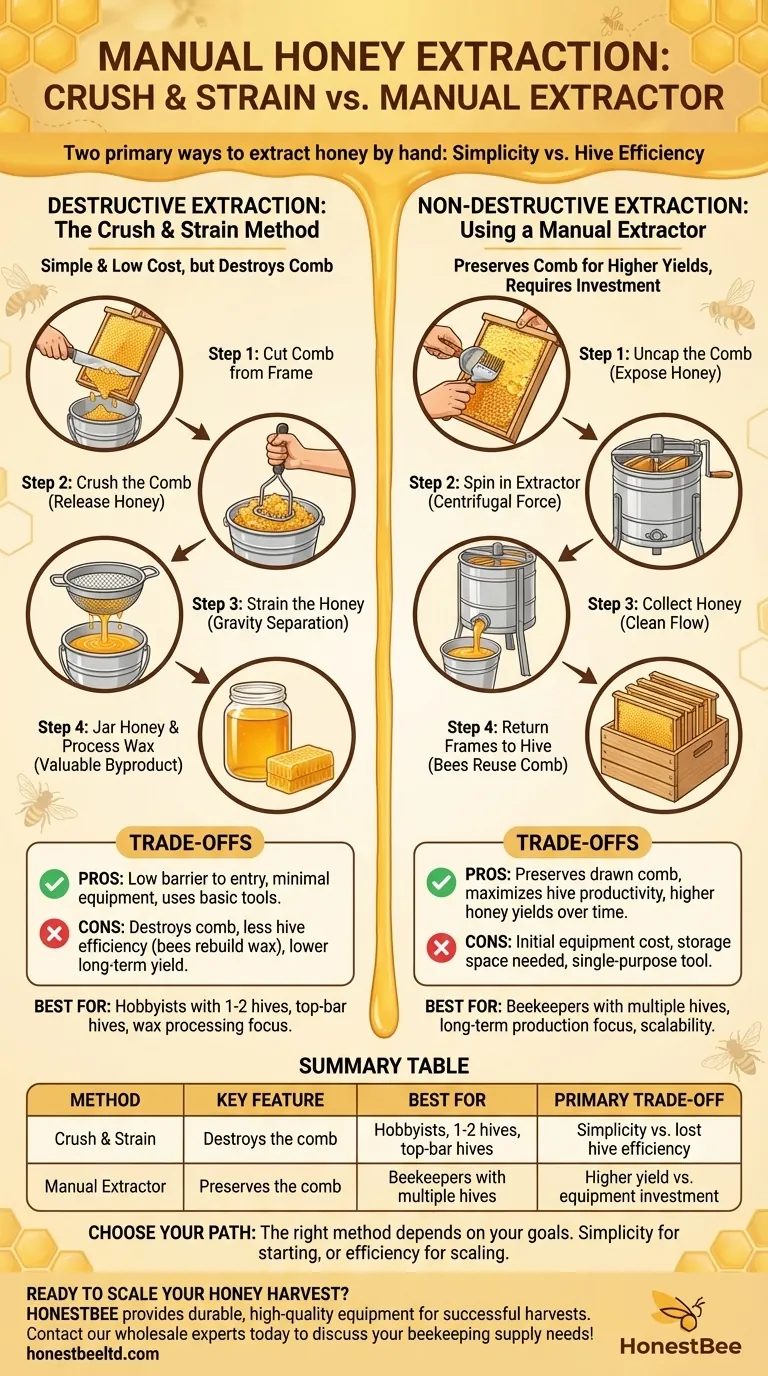
Related Products
- 2 Frame Stainless Steel Manual Honey Spinner Extractor for Beekeeping
- Plastic Hand Crank 2 Frame Honey Extractor Low Price
- HONESTBEE 3-Frame Manual Acrylic Honey Extractor
- HONESTBEE 4 Frame Manual Self Reversing Honey Extractor for Beekeeping
- Stainless Steel Manual 8 Frame Radial Honey Extractor Machine for Beehives
People Also Ask
- How does centrifugation work in honey extraction? The Sustainable Method for Modern Beekeepers
- What are some expert tips for cleaning a honey extractor? Protect Your Harvest & Equipment
- How do beekeepers harvest honey from the honey super? A Step-by-Step Guide to Efficient Extraction
- What mistakes should be avoided during honey extraction with a centrifuge? Preserve Your Comb and Honey Quality
- How can a pressure washer be used to clean a honey extractor? A Guide to Safe and Efficient Cleaning



